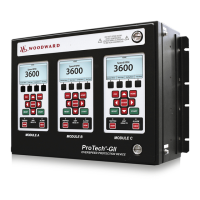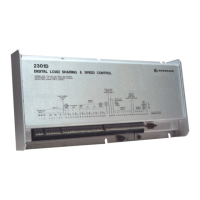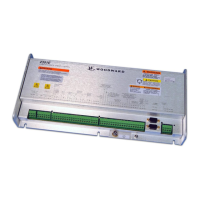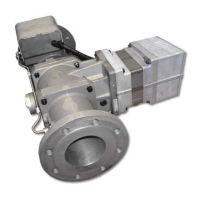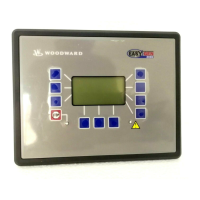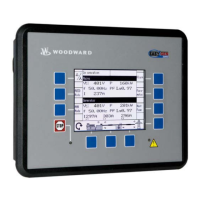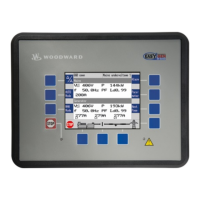Manual 37365A GCP-30 Series Packages - Genset Control
Page 54/179 © Woodward
Re-synchronization of the busbar to the mains: The system is operating as an isolated system, for synchroni-
zation to be performed the voltage and frequency differentials of the mains and bus must be within the confi-
gured windows.
The bus frequency reference point is dictated by the monitored mains frequency and the configured frequency
differential (+ df
max
/2).
Example: If +df
max
= 0.2 Hz, the GCP-30 will calculate the bus frequency reference point as:
[monitored mains frequency] + [df
max
/2] = bus frequency reference point
A practical example of this would be:
The monitored mains frequency is 60 Hz
Configured + df
max
= 0.2 Hz
[60 Hz] + [0.2Hz/2] = 60.1 Hz bus frequency reference point
The differential voltage is configured as a window. The monitored voltage from the potential transformers sec-
ondary for the mains and the bus must be within the configured voltage differential limit. This means that if the
secondary voltage inputs have been configured for 120 V and a dV of 2 V is configured, then synchronization
will be permitted when the monitored voltage on the secondary of the main and bus are within 2 V of each other.
When the monitored bus frequency and voltage are within the configured differential limits, the "Command:
close MCB" relay will enable, closing the MCB, and the system will be paralleled to the mains.
Prerequisites: All GCP-30 controllers connected to the system must have rated system frequencies and breaker
logic configured identically and the parameter "Active power load-share" (Parameter 90) must be enabled.
Description of the load-share interface: Th
e GCP-30 utilizes a peer relationship between units to control the
system. This permits for parallel applications of up to 14 generators.
NOTE
Refer to the Interface section of the Installation Manual 37364 for information about the CAN bus con-
nection.
Diagram of load/var sharing via the CAN bus (refer to Figure 3-4 on page 36): Th
e parameter "Active load
sharing factor" determines if and how a generator performs real power or frequency control when paralleled with
other generators in an isolated operation. This parameter is defined as a percentage. In the figure below 10 %
means increased real power control and 99 % increased frequency control. This parameter must be configured
individually for each generator.
In the illustrated control system, it must be noted that each control calculates the mean utilization factor of all
controls from the data transmitted via the CAN bus and then compares this with its own utilization factor. The
utilization factor is compared with the reference variable and results in a new reference variable set point. Fre-
quency and real power control are carried out simultaneously in these controls (corresponding to the reference
variable).
Frequency control is carried out via the measured voltage/frequency of the voltage system. The Pickup is used
merely for monitoring functions, or is available as a control value to the secondary controller.

